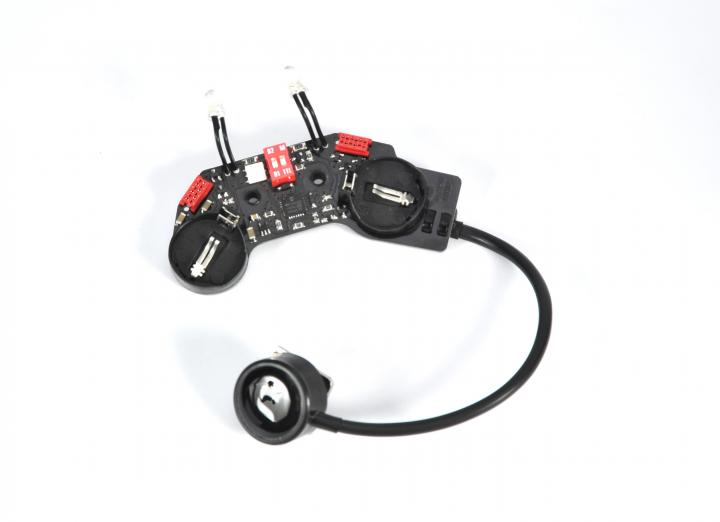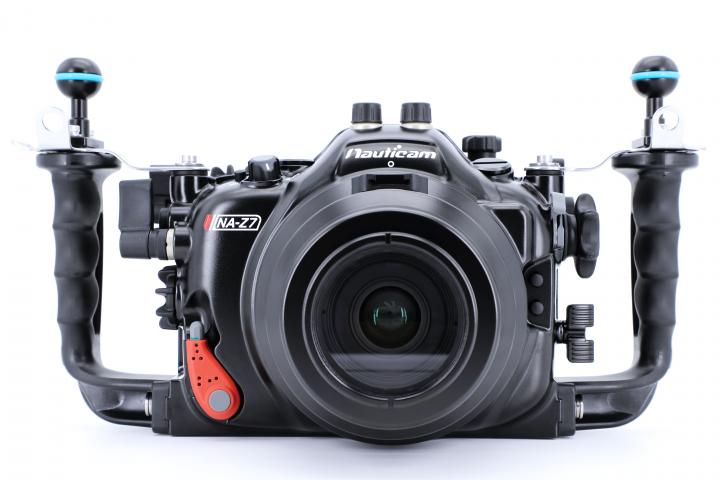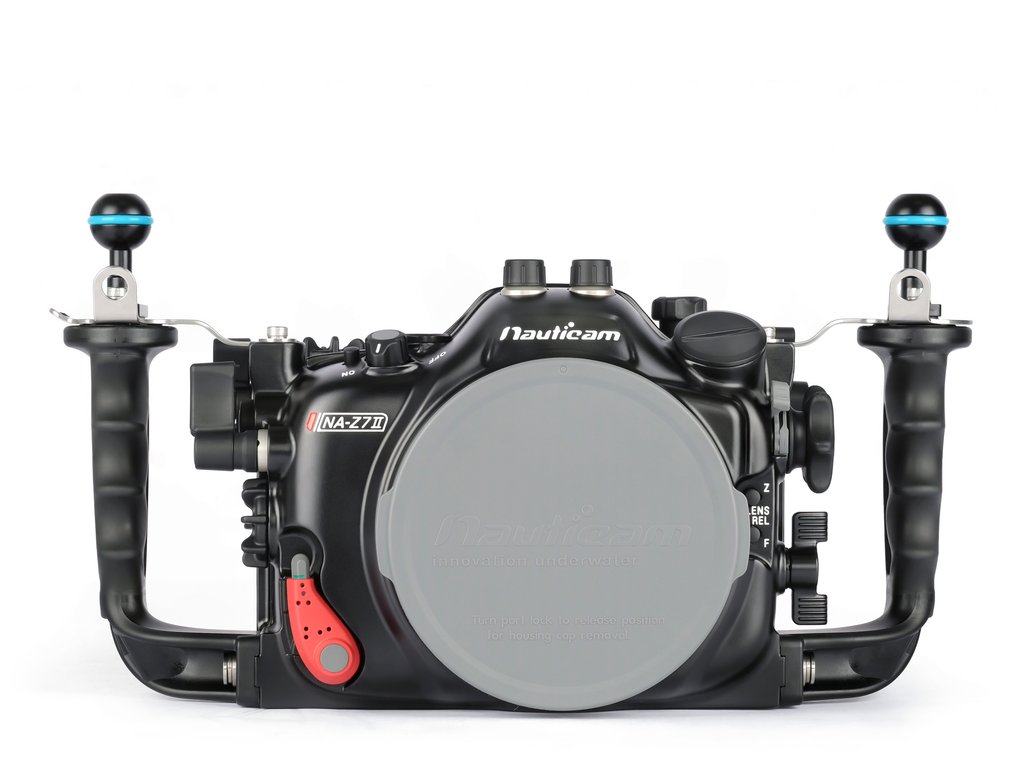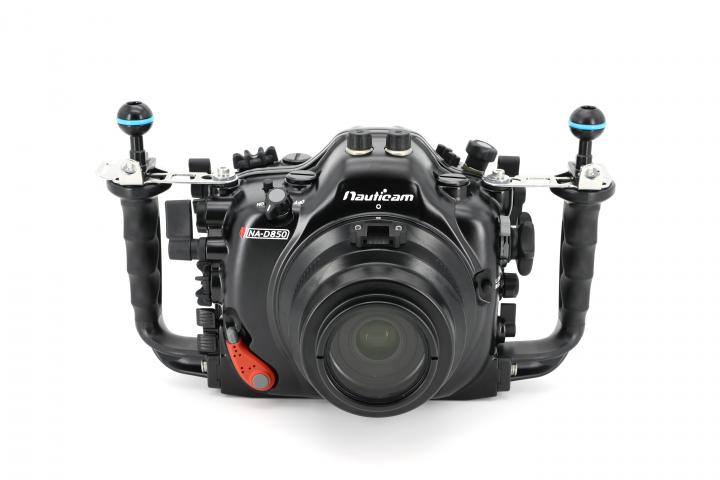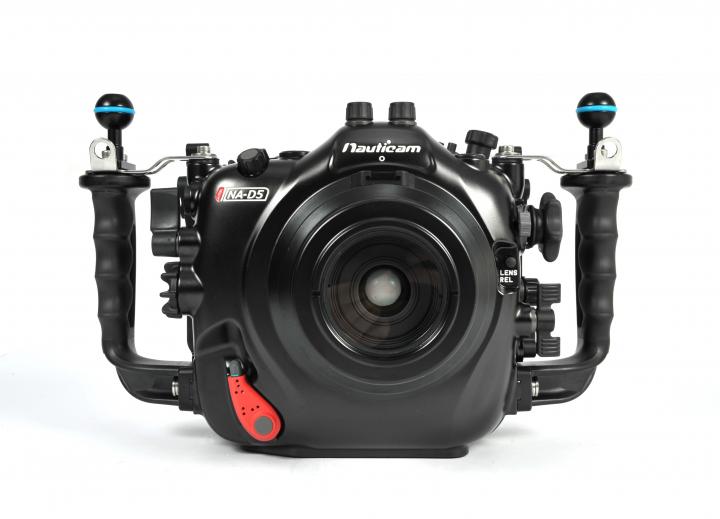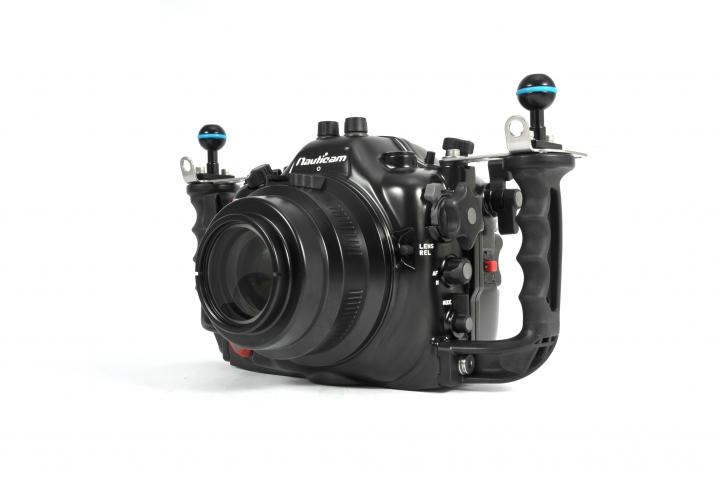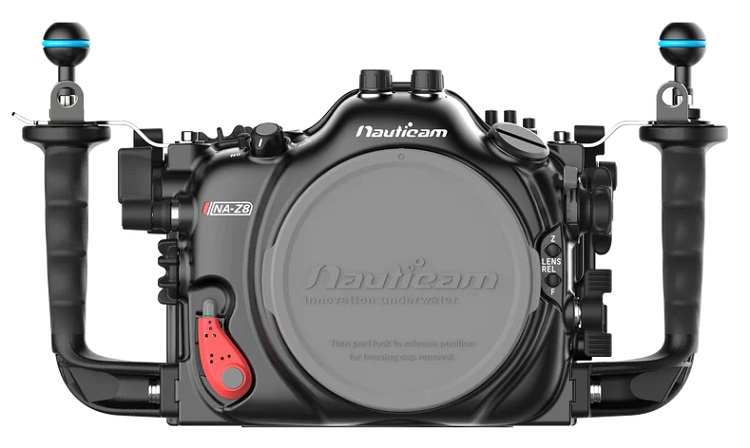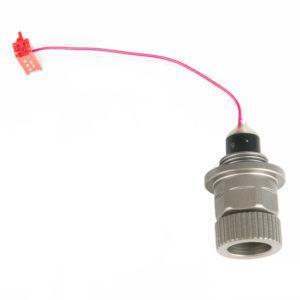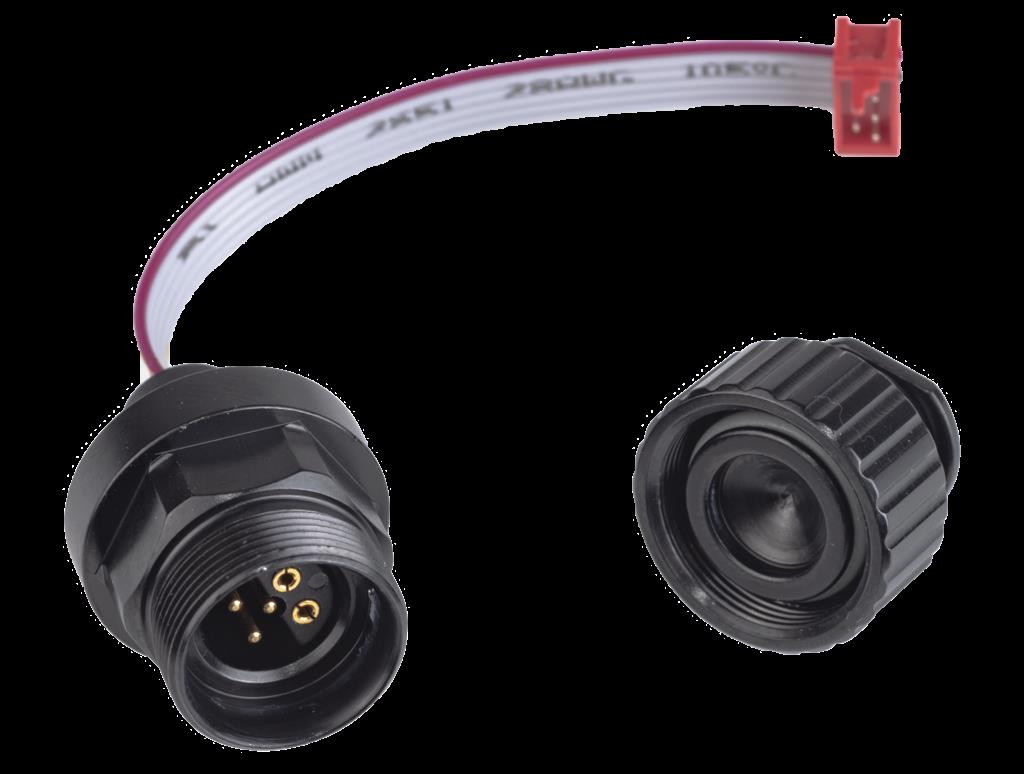Nikon D5 Underwater Housing by Nauticam
Nikon pro-series bodies are the cameras that can go anywhere, withstanding unbelievable punishment in the field, and bring back images bordering on the fringes of what is possible from current imaging technology. The Nauticam NA-D5 is an ergonomic, rugged, and reliable underwater housing ready to take the camera below the surface to the ends of the earth in search of these photographic fringes that make the rarest and most memorable images.
THE NIKON D5
Pro body performance is difficult to quantify on paper, but immediately evident when holding the camera in hand. Metal construction inspires confidence. The 12 fps continuous shooting speed (with AF) and a 200 shot RAW buffer keeps up with the fastest action. A large, bright viewfinder offers a clear view of the shooting scene, and Multi-CAM 20K tracks focus with incredible accuracy. The D5 is capable of 3,780 shots per charge (according to the CIPA rating). While the Nikon D4 was already a Professional Performance Powerhouse, the D5 is even better.
Nikon has upped the resolution count in D5 from 16 to 20.8 megapixels, but that is far from the most exciting news for most users. More interesting is the launch of the Multi-CAM 20K. This new autofocus system features 153 focus points (up from 51), of which 99 are cross-type sensors (up from 15). D5 has more cross-type focus points than the D4s had total focus points, and they are spread wider across the frame. The autofocus system in the D4s was already one of the best available, and the improvements offered by D5 will elevate performance even further. The D5 introduces a new, 180k pixel RGB metering sensor. This metering sensor drives the advanced Nikon exposure system, and is also used to provide scene data for 3D focus tracking, improving accuracy.
In total, this is an extremely significant upgrade from Nikon. D4s was already one of the best pro bodies in overall low light performance. D5 increases the high ISO range to ISO 102,480, capable of being pushed to 3,280,000. The D5 camera has a better 3.2? LCD review screen with touch capability, and the most advanced auto focus system ever released. It is also the first Nikon DSLR body capable of 4K video capture. High frame rate capability allows more captures, and Multi-CAM 20K Focus ensures more in focus captures.
NIKON D5 KEY FEATURES:
20.8 Megapixel Resolution FX Format CMOS Sensor
4K UHD Video Capture at 24/25/30P
Multi-CAM 20K Autofocus with 153 focus points
180,000 RGB Metering Sensor
12 fps Continuous Shooting with Autofocus
ISO 100-102,400 (expandable to 3,280,000)
3.2? 2.36 m-dot XGA LCD Screen with Touch Functionality
3,780 Shots per Battery Charge (CIPA Rating)
Dual XQD or CF Memory Slots
THE NAUTICAM NA-D5 UNDERWATER HOUSING
Nauticam housings are evolutionary marvels, with advancements from previous systems providing the foundation that new models are built on. The Nauticam NA-D5 housing incorporates advances from the NA-D4 that came before it, but features enhanced ergonomics, a more sophisticated flash triggering system, along with reduced size and weight thanks to cutting edge manufacturing processes.
The NA-D4 was a significant evolution of the Nauticam DSLR housing. Key controls, such as ISO, Video Record, Playback, and Info were routed out to the housing grips. Nauticam recognizes that advanced DSLR cameras, and advanced DSLR users, rely on these functions more than ever to realize the full potential of advanced imaging systems and wanted to bring them within easy reach from the handles.
Advanced high-ISO and video functionality in modern DSLR cameras has redefined what controls are really considered essential. Buttons that seem like an afterthought in the D5 camera control layout, such as Info (which displays shooting data on the 3.2? color lcd screen), are critical for use in the housing. This button is routed to the left handle for convenient access. AF-ON, Movie Record, Playback, ISO, Pv, Fn1, Fn2 and Live View are all handled similarly. Considerable design and manufacturing resources go into this ergonomic reshuffling, but the benefit to the user experience makes is worth the effort.
EXTERNAL FLASH TRIGGERING
The entire external flash triggering system has has been reworked from the ground up in NA-D5, increasing ease of use, setup convenience, and reliability. A new LED flash triggering system is standard in every housing.
The Nikonos style bulkheads included in NA-D4/NA-D4s have been replaced by an integrated LED flash trigger in the NA-D5. This optical flash trigger can fire at the full 14fps of the camera (mirror locked up). Optical systems, with fiber optic cables linking the external flashes to the housing, are far more reliable than any electrical sync cable system.
The LED trigger circuitboard is mounted inside the housing, and connected to the camera with a hotshoe cable. This new system is more powerful than the hotshoe mounted LED triggers used in the past, and is compatible with all currently available optically triggered flashes. Powered by two CR2032 batteries, battery life is measured in the tens of thousands of flashes, driven by incredibly efficient electronics. With good batteries, we expect 3-5 years of service, up to 50,000 exposures.
Users of legacy flashes without optical triggering are able to add accessory Nikonos (26074) or Ikelite (26075) style bulkheads for electrical flash sync. These bulkheads plug into the LED trigger board for clean cable routing, and reliable connection.
ACCESSORY TTL CONVERTER
The NA-D5 is compatible with the Nauticam TTL Converter (26308). This user installable upgrade provides accurate automatic TTL flash exposure with a number of popular flashes, and offers both optical and electrical strobe triggering in a single unit.
Optical triggering, using an LED integrated into the board and fiber optic cable, works well with modern flashes like Inon Z-240, Sea & Sea YS-D2, and more. Electrical triggering supports Ikelite DS- and Sea & Sea YS-250 strobes connected via an electrical sync cord.
To trigger your strobes electronically (YS-250 and Ikelite), add the appropriate electrical bulkhead and connect to the flash trigger board via two red Micro-MaTch connectors.
Two new electrical bulkheads have been created just for this purpose.
NA26074 Nikonos Style Bulkhead
NA26075 Ikelite Style Bulkhead
EXTENSIVE CUSTOMIZATION FOR A TAILORED ERGONOMIC EXPERIENCE
Professional Nikon cameras are known for to be extensively customizable. NA-D5 offers access to more of these functions than any previous Nikon DSLR, with the ergonomic treatment that have made Nauticam housings legendary.
Pv is routed from the lens mount, and placed just under the right handle. Fn1 & Fn2 are moved all the way to the left side of the housing to avoid crowded right hand grip.
These custom functions can be overwhelming at first, but the creative options they unlock can be incredibly valuable in the field. In short, these assignable buttons mean less time digging through camera menus to change camera functions, and more time capturing the scene as it unfolds.
There isn't a right way configure these systems. Every photographer and shooting scenario has unique demands. Some ideas are listed below.
1 Step Spd / Aperture, allows changing exposure settings in full f-stop increments. Think about changing from a wide angle scenic mode with relatively open aperture and slow shutter speed to a close focus wide angle shot that requires a closed aperture to shrink a sunball.
My Menu, a customized panel with frequently accessed menus settings
Access Top Item in MY MENU, actually jumps into a frequently accessed sub menu structure for the top level My Menu selection, saving at least two button presses. (ie min shutter speed in auto iso mode, or quickly define a preset white balance)
Quickly access another metering mode, toggling between the selected metering pattern and an alternate that more appropriately mesures the current scene.
Flash disable / enable, this is a big one! Toggles external flashes on and off, allowing a switch between artificial light shooting (continuous shooting speed limited by flash recycle, and shutter speed limited by the strobe max sync speed at 1/250) to silhouette mode using only ambient light (full 12 fps continuous shooting speed, unrestricted flash sync speed).
AF-area mode + AF-ON – very cool functionality, for a quick way of accessing a focus mode other than the mode currently assigned and activating it while held down. Placed at the right thumb via the re-positioned PV lever, the current focus mode be overridden with something like auto area focus for quick grab shots where there isn't time to move the selected autofocus point.
The redesigned LED Flash Triggering System has allowed for a much lower housing height. This the smallest, easiest to pack Nauticam Pro DSLR housing yet. Compared to NA-D4, the previous Nikon pro-body housing from Nauticam, the smaller size is immediately apparent.
VIEWFINDERS
The standard optical glass viewfinder is very good and travel friendly, but many photographers prefer the ease of a magnified viewfinder with adjustable diopter. Nauticam produces a "straight" 180º enlarging viewfinder and a 45º angled enlarging viewfinder to enhance the ease of close quarters work often associated with macro shooting. Both viewfinders have high quality optics, and allow bright viewing of the entire image. A patented external dioptric adjustment allows personal adjustment to a sharp-as-a-tack standard underwater and viewfinder changes can be executed in less than 30 seconds without using tools. Exceptional composition and focus accuracy have never been more accessible.
PREMIUM PROFESSIONAL OPTICS
Experienced shooters know a camera is only as good as the lens in front of it, and the same is true when choosing optics for an underwater camera system. Four optically coated glass dome ports (250mm, 230mm, 180mm, and 140mm diameters) and a series of acrylic ports support popular lenses from Nikon, Sigma, and Tokina. Port configurations are extensively tested at Nauticam to determine the ideal extension ring length for best performance. The large 120mm housing port opening allows even the largest popular pro Nikon wide angle lens (14-24 /2.8G) to be used, and the camera can even be mounted in the housing with this large lens attached.
For macro and super macro shooting, the Nauticam Super Macro Converter is a revolutionary accessory. This is an entirely in house design, optimized for use in water. The water contact correction offers the highest overall sharpness, free from chromatic aberration and purple fringing, with reproduction ratios exceeding 2:1 when used with a Nikon AF-S 105mm /2.8 VR Lens.


